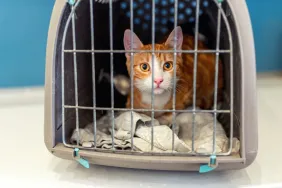Apoquel is a medication prescribed for pets — particularly dogs — to alleviate symptoms associated with allergic dermatitis, such as itching and inflammation. The FDA has not officially approved the use of Apoquel in cats. However, since its introduction to the market in 2013, the drug’s efficacy in cats has been subject to extensive study. Reports have indicated varying degrees of success and safety in the off-label use of the drug.
Here’s what you should know about the uses, dosage, and side effects of Apoquel for cats.
Uses of Apoquel for cats
The active ingredient in Apoquel is oclacitinib. It works by inhibiting the function of certain proteins — JAK enzymes — involved in the itch and inflammation pathways. For cats suffering from conditions like allergic dermatitis or atopy, Apoquel could provide significant relief. The medication is especially beneficial for felines who haven’t responded well to traditional antihistamines or corticosteroids. It’s essential to note, however, that these uses are off-label, and you should only consider Apoquel for your cat under the direct supervision of a veterinarian experienced in its use in felines.
That said, Apoquel is only recommended for use in dogs who are over 12 months of age. This is because younger dogs, under one year old, have not yet developed mature immune systems. Although primarily focused on dogs, this precaution is advisable for cats as well.
Dosage of Apoquel for cats
The following information is meant as a guideline for the typical use of the drug in cats. It must not replace your vet’s advice for your individual pet.
The appropriate dosage of Apoquel for cats is not officially established. Dosage recommendations currently in use are derived from dermatology research involving cats, coupled with the veterinary community’s practical experience with the medication over recent years. Apoquel is available in oral tablet form in different strengths — 3.6 mg, 5.4 mg, and 16 mg. You may need to conceal the medication in food or a pill pocket to facilitate easier ingestion for your cat.
For many cats, a common starting dosage of Apoquel is typically 2.7 mg. This equates to half of a 5.4 mg tablet. Depending on your cat’s size and their specific condition, your veterinarian might adjust this dosage accordingly.
When it comes to dosing dogs with Apoquel, the initial regimen involves administering the medication every 12 hours during the first 14 days. After this period, the frequency is reduced to once a day, every 24 hours. Should a dog, who is well-managed on a once-daily dose, experience a sudden allergy flare-up, the dosage can be temporarily increased back to twice a day for up to 14 days.
Most vets prescribe a similar dosing schedule for cats. However, long-term or excessive dosing can elevate the risk of immune suppression in both cats and dogs
Managing atopic dermatitis in cats often requires a nuanced approach, and Apoquel may not always be the sole or first line of treatment. Your vet may incorporate other medications into the treatment plan. These can include glucocorticoids like prednisolone, allergy-specific immunotherapy, antibiotics, and cyclosporine. Furthermore, your vet might advise you to consult with a veterinary dermatologist to effectively manage your cat’s allergic skin conditions.
Side effects of Apoquel for cats

Apoquel has been a game-changer for many dogs. Nonetheless, side effects experienced by cats could differ, and research in this area is still emerging. Some of the potential side effects include:
- Vomiting
- Diarrhea
- Lethargy
- Appetite changes
- Potential susceptibility to infections due to immunosuppressive effects
Apoquel should be used with caution in pets who have been diagnosed with cancer. The drug can inhibit certain cytokines, which play a critical role in the body’s immune response against various types of cancer. By suppressing these cytokines, there’s a potential risk that the medication could either trigger the development of cancer or exacerbate existing conditions. Additionally, you should use Apoquel cautiously in pets experiencing an active infection unrelated to allergic skin diseases, such as urinary tract infections or pneumonia.
There have been no reported interactions between Apoquel and other drugs. However, its effects have not been thoroughly evaluated when used alongside corticosteroids, cyclosporine, or other medications known to suppress the immune system significantly.
The manufacturer, Zoetis, notes that Apoquel has been successfully used with vaccines, non-steroidal anti-inflammatory drugs (NSAIDs), anticonvulsants, antibiotics, parasiticides, and allergen immunotherapy. While these findings are based on studies conducted in dogs, it is likely they could apply to cats as well. However, specific interactions in cats have not been studied extensively.
It’s essential to monitor your cat closely for any adverse reactions after starting Apoquel and report them to your veterinarian immediately. The decision to continue or adjust the medication will depend on the severity of the side effects compared to the benefits observed in managing the allergic condition.









